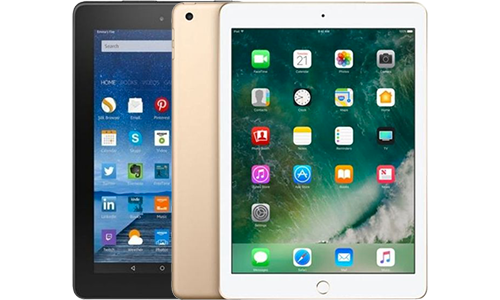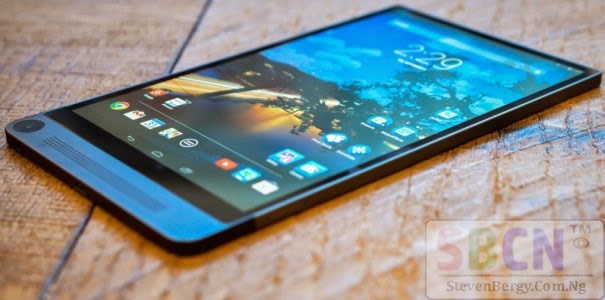Tablets
A tablet computer, commonly shortened to tablet, is a portable PC, typically with a mobile operating system and LCD touchscreen display processing circuitry, and a rechargeable battery in a single thin, flat package. Tablets, being computers, do what other personal computers do, but lack some I/O capabilities that others have. Modern tablets largely resemble modern smartphones, the only differences being that tablets are relatively larger than smartphones, with screens 7 inches (18 cm) or larger, measured diagonally and may not support access to a cellular network.

The touchscreen display uses gestures by finger or stylus instead of the mouse, trackpad and keyboard of larger computers. Portable computers can be classified according to the presence and physical appearance of keyboards. Slates and booklets do not have a physical keyboard, and usually accept text and other input by use of a virtual keyboard shown on a touchscreen-enabled display. Hybrids, convertibles, and 2-in-1s all have physical keyboards (although these are usually concealable or detachable), yet they typically also make use of virtual keyboards. Some 2-in-1s have processors and operating systems like a full laptop, whilst having the flexibility of being used as a tablet. Most tablets can use separate keyboards connected using Bluetooth.
The format was conceptualized in the mid-20th century (Stanley Kubrick depicted fictional tablets in the 1968 science fiction film 2001: A Space Odyssey) and prototyped and developed in the last two decades of that century. In 2010,[5] Apple released the iPad, the first mass-market tablet to achieve widespread popularity. Thereafter tablets rapidly rose in ubiquity and briefly became a large product category[6] used for personal, educational and workplace applications. From the mid-2010s, tablet computers started to decline, having been surpassed by both 2-in-1 hybrids and larger-sized smartphones
Tablet computers appeared in a number of works of science fiction in the second half of the 20th century; all helped to promote and disseminate the concept to a wider audience.[12] Examples include:
Isaac Asimov described a Calculator Pad in his novel Foundation (1951)
Stanislaw Lem described the Opton in his novel Return from the Stars (1961)
Numerous similar devices were depicted in Gene Roddenberry’s 1966 Star Trek: The Original Series
Arthur C. Clarke’s NewsPad[13] was depicted in Stanley Kubrick’s film 2001: A Space Odyssey (1968)
Douglas Adams described a tablet computer in The Hitchhiker’s Guide to the Galaxy and the associated comedy of the same name (1978)
The sci-fi TV series Star Trek The Next Generation featured tablet computers which were designated as PADDs.[14]
A device more powerful than today’s tablets appeared briefly in The Mote in God’s Eye (1974).[15]
The Star Wars franchise features “datapads”, first described in print in 1991’s Heir to the Empire and depicted on screen in 1999’s The Phantom Menace.
Additionally, real-life projects either proposed or created tablet computers, such as:
In 1968, computer scientist Alan Kay envisioned a KiddiComp;[16][17] he developed and described the concept as a Dynabook in his proposal, A personal computer for children of all ages (1972),[18] which outlines functionality similar to that supplied via a laptop computer, or (in some of its other incarnations) a tablet or slate computer, with the exception of near eternal battery life. Adults could also use a Dynabook, but the target audience was children.
In 1979, the idea of a touchscreen tablet that could detect an external force applied to one point on the screen was patented in Japan by a team at Hitachi consisting of Masao Hotta, Yoshikazu Miyamoto, Norio Yokozawa and Yoshimitsu Oshima, who later received a US patent for their idea.[19]
In 1992, Atari showed developers the Stylus, later renamed ST-Pad. The ST-Pad was based on the TOS/GEM Atari ST Platform and prototyped early handwriting recognition. Shiraz Shivji’s company Momentus demonstrated in the same time a failed x86 MS-DOS based Pen Computer with its own GUI.

In 1994, the European Union initiated the NewsPad project, inspired by Clarke and Kubrick’s fictional work.[21] Acorn Computers developed and delivered an ARM-based touch screen tablet computer for this program, branding it the “NewsPad”; the project ended in 1997.[22]
Risc User: NewsPad Covered in the October 1996 edition
During the November 2000 COMDEX, Microsoft used the term Tablet PC to describe a prototype handheld device they were demonstrating.
